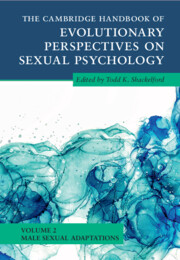Book contents
- The Cambridge Handbook of Evolutionary Perspectives on Sexual Psychology
- The Cambridge Handbook of Evolutionary Perspectives on Sexual Psychology
- Copyright page
- Contents
- Contributors
- Preface
- Part I Precopulatory Adaptations
- Part II Copulatory Adaptations
- Part III Postcopulatory Adaptations
- 14 Postejaculatory Adaptations to Self-Semen Displacement
- 15 Male Mate Retention
- 16 Shifts in Partner Attractiveness
- 17 Emotional Commitment in Men
- 18 Sexual Jealousy in Males
- 19 Men’s Attachment-Related Needs in the Sexual Arena
- 20 Paternal Care
- 21 Paternal Filicide
- Index
- References
19 - Men’s Attachment-Related Needs in the Sexual Arena
from Part III - Postcopulatory Adaptations
Published online by Cambridge University Press: 30 June 2022
- The Cambridge Handbook of Evolutionary Perspectives on Sexual Psychology
- The Cambridge Handbook of Evolutionary Perspectives on Sexual Psychology
- Copyright page
- Contents
- Contributors
- Preface
- Part I Precopulatory Adaptations
- Part II Copulatory Adaptations
- Part III Postcopulatory Adaptations
- 14 Postejaculatory Adaptations to Self-Semen Displacement
- 15 Male Mate Retention
- 16 Shifts in Partner Attractiveness
- 17 Emotional Commitment in Men
- 18 Sexual Jealousy in Males
- 19 Men’s Attachment-Related Needs in the Sexual Arena
- 20 Paternal Care
- 21 Paternal Filicide
- Index
- References
Summary
The attachment and sexual-mating behavioral systems operate jointly within romantic relationships and their reciprocal influences shape relationship quality and longevity. In line with evolutionary models and social perspectives, substantial evidence indicates that men and women differ in the sex-attachment linkage, such that men are more permissive in their sexual attitudes, adopt a more individualistic and pleasure-centered orientation toward sexuality, and are less likely to connect sexual encounters with emotional bonding relative to women. Men's higher sexual urges may also be related to common beliefs which assume that they are constantly interested in having sex, regardless of contextual cues. However, in the context of ongoing relationships, men's sexual motivations may be attuned to relationship goals and shaped by contextual factors such as their partner's responsiveness, attachment-related insecurities, and relationship duration. In this chapter, I present a more complex and nuanced picture of the sex-attachment linkage in men and discuss the multifaceted nature of their sexual desire within the relationship context. I review findings that demonstrate the role of men's sexual desire in the formation and maintenance of intimate relationships and challenge the common notion of the disconnect between men's sexual motivations and attachment needs. I also discuss the ways in which women's perceived responsiveness may shape men's sexual desire and felt security, especially among insecurely attached men. Furthermore, I review findings on the effect of women's displays of desire on men's attachment-related worries and dilemmas. Finally, I present findings on changes over relationship duration in men's sexual desire in committed, long-term relationships and discuss the importance of considering men's age when examining longitudinal effects of their desire and the extent to which men endorse emotional connection in sexual interactions. I conclude by discussing how men may satisfy relationship-related needs within the sexual arena in different relationship stages.
- Type
- Chapter
- Information
- Publisher: Cambridge University PressPrint publication year: 2022



